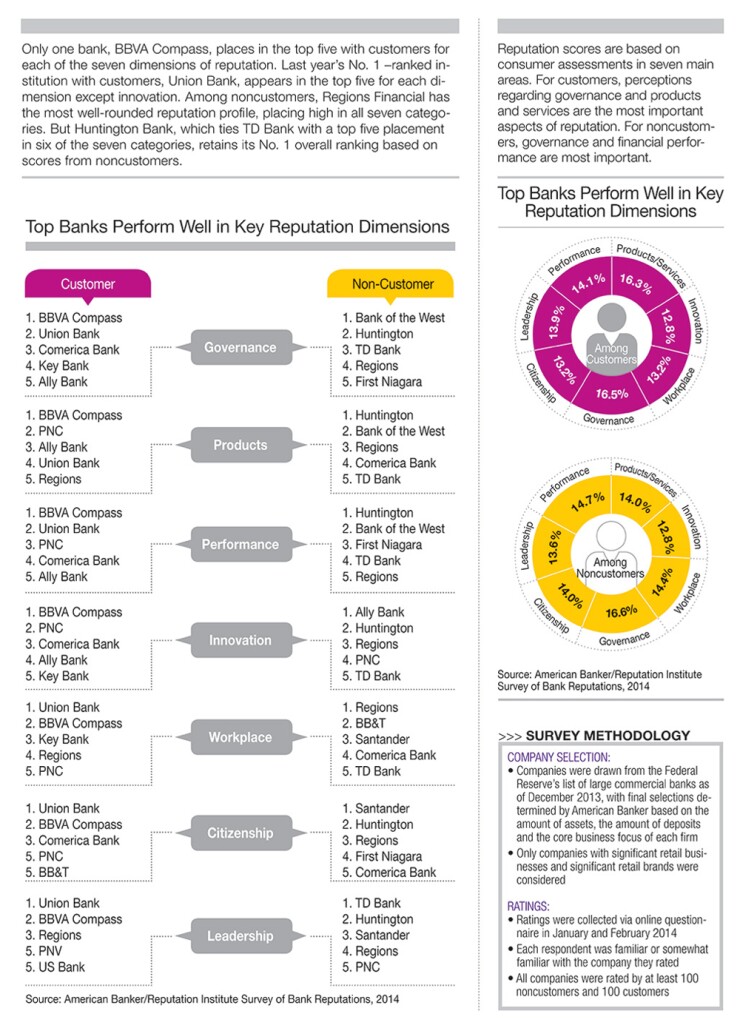




When we began our annual survey of bank reputations five years ago, we knew we'd see signs of a sector in crisis, and not just a financial one. Banks of all sizes and in all geographies were reeling from a widespread breakdown in customer trust.
What was interesting to watch in subsequent years was the way nuance returned to the marketplace, as indiscriminate resentment toward banks gave way to more considered views. Each year, one or two institutions would pull away from the pack, proving it was possible to make reputation a positive point of differentiation even as the industry as a whole continued to be viewed more skeptically than just about any other sector of the economy.
So it's notable this year that bank reputations once again seem to be moving in lockstep. Only this time, they're marching in a far more favorable direction.
There are still winners and losers that stand out, particularly when you ask people about the institutions they directly do business with. But it's telling that with noncustomers, a tougher crowd by far, every one of the 25 large retail bank brands in this year's American Banker/Reputation Institute study fared better than last year. And a dozen brands improved their standing enough to move out of the zone where their scores indicate a weak or vulnerable reputation.
When evaluated by their own customers, 18 of the 25 bank brands on this year's survey garner scores of 70 or higher on our 100-point scale, indicating strong or robust reputations. And one institution, BBVA Compass, came within two points of achieving a "top-tier" score of 80 or higher, territory no bank has seen since our survey started in 2010. (To see a Q&A with BBVA Compass CEO Manolo Sánchez,
Another milepost this year: Wells Fargo now finds itself in the company of brands with strong or robust reputational strength, based on the perceptions of the firm's own customers, and another of the big four banks, Citibank, was on the cusp of achieving a similar feat. Both brands, however, are still in a reputationally weak or vulnerable position with noncustomers, as are Bank of America and Chase.
On the whole, this year's snapshot shows strong signs that consumer perceptions of the bank sector are on the mend. Credit the passage of time, the careful rebuilding of trust by a chastened industry or maybe just the sheer industriousness of the legal department at JPMorgan Chase the bank entered into a series of multibillion-dollar, headline-grabbing settlements that perhaps contributed to a feeling among consumers still simmering over the financial crisis that justice at long last had been served. In any case, the public's animus toward banks appears to be receding.
Compared with other sectors tracked by Reputation Institute, a reputation management consultancy, banks are no longer at the bottom of the barrel, as they have been for the past several years. This year, banks climbed past the media, energy and telecommunications sectors, based on industrywide reputation score averages.
Anthony Johndrow, a managing partner at Reputation Institute, says that 2014 "might be the turning point for perceptions" of the banking industry, with consumers finally giving banks permission to recalibrate the conversation around brand promise and trust.
"To be sure, most banks have a long way to go; many are still in the 'weak' range among noncustomers," Johndrow says. "But we think that people are willing to be receptive to the good things that banks do."





